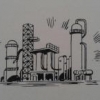Latest Downloads
-
 Water Bath Indirect Heaters
Water Bath Indirect HeatersArt Montemayor - Oct 12 2018 02:35 PM
-
 Petroleum: A Primer for Kansas
Petroleum: A Primer for KansasArt Montemayor - Oct 12 2018 02:27 PM
-
 Spray Tower for Flue Gas Scrubbing Design
Spray Tower for Flue Gas Scrubbing Designankur2061 - May 02 2018 02:31 PM
-
 Selection of Vertical Tanks
Selection of Vertical Tanksankur2061 - Apr 19 2018 07:42 AM
-
 Pressure Drop Calculator for Strainers 1
Pressure Drop Calculator for Strainers 1ankur2061 - Mar 24 2017 02:04 PM
-
 Horizontal Pig Trap System Design Guidelines
Horizontal Pig Trap System Design Guidelinesankur2061 - Jan 14 2017 02:54 PM
-
 Performance Prediction of 3-Stage Propane Refrigeration System
Performance Prediction of 3-Stage Propane Refrigeration Systemankur2061 - Aug 08 2016 02:43 PM
-
 Centrifugal Pump Troubleshooting Checklist
Centrifugal Pump Troubleshooting Checklistankur2061 - Dec 17 2015 08:18 AM
-
 Compressor Troubleshooting Checklist
Compressor Troubleshooting Checklistankur2061 - Sep 08 2015 11:43 AM
-
 Amine Sweetening Unit Preliminary Design
Amine Sweetening Unit Preliminary Designankur2061 - May 19 2015 09:35 AM
Popular Store Titles
 Tank Jacket Calculator
Tank Jacket Calculator
 Specification Sheet Collection
Specification Sheet Collection
 PIPESIZE
PIPESIZE
 Relief Valve Sizing
Relief Valve Sizing
 Rupture Disc Sizing
Rupture Disc Sizing
Chemical and Process Engineering Resources
Submitted Chris Haslego, Nov 21 2011 11:21 AM | Last updated Nov 21 2011 01:29 PM
| Category: | Separation Technology |
| Question: | Why is it sometimes necessary to distill under a vacuum and what are the special considerations involved? |
| Keywords: | vacuum,distillation,design,pit,falls,consideration,separation,sub-atmospheric |
| Answer: | The main reason for distilling under a vacuum is to carry out the operation at a relatively low temperature which corresponds to the lower vapor pressure imposed on the process. The design of a vacuum tower is much like a conventional one except that you are constantly under the constraint of a limited available pressure driving force within the system and this causes liquid and vapor distribution problems that affect the controls and the ultimate separation. You only have a maximum of 14.7 psi to carry out the operation and you can't afford to waste any part of it. 1. Be aware that accurate and dependable process control is essential. Refer to Greg Shinskey's great book, "Distillation Control", pages 103 and 121. Vacuum distillation is very sensitive to pressure and temperature control. This is an area that takes design experience, so don't feel bad if you make some blunders.2. Tray design is very special and usually left up to the experts who fabricate and install them. However, you must at least be knowledgeable in preselecting the type of tray that can do the job for you. The pressure drop per tray that you obtain will usually be very critical to maintain in order to keep the separation successful. In some applications, it is necessary to add an inhibitor to prevent unwanted polymerization3. Be prepared to confront a reboiler design that will require close details and scrutiny because of hot spots and the need to reduce pressure drops. You may have to employ a forced circulation type of reboiler.4. Overheads condenser design is also not your usual, conventional type of design. You will have to keep pressure drops down while maintaining vacuum. This is a very specialized area and handled by fabricator experts in real life. However, you must specify the conditions and limitations. A TEMA shell type H or J is usually used to divide the shell vacuum side flow and keep the pressure drop low. Remember, pressure drop is very expensive in this type of separations. Look for ways to reduce it.5. Because of the special conditions imposed on the reboilers and condensers you will find that you will need to concentrate on your equipment layout and vertical orientation in order to assure dependable NPSH values on your pumps and controls.All the above adds structural steel and height requirements which represent additional capital costs. Design for maximum welded construction on your process vessels, especially the towers. Avoid gasketed connection as much as you can. You must keep down the infiltration of atmospheric air into your vacuum or it will cost you capacity and temperature controls while it is operating. |
Forum Quick Links
Tech Q & A Category List
-
 Bulk Solids
Bulk Solids
-
 ChE Outside the Plant
ChE Outside the Plant
-
 Chemical Process Business
Chemical Process Business
-
 Chemistry Basics
Chemistry Basics
-
 Corrosion
Corrosion
-
 Equipment Design
Equipment Design
-
 Experimentation and Testing
Experimentation and Testing
-
 Fluid Dynamics
Fluid Dynamics
-
 Heat Transfer Technology
Heat Transfer Technology
-
 Industrial Utilities
Industrial Utilities
-
 Mass Transfer
Mass Transfer
-
 Physical Property Information
Physical Property Information
-
 Plant Basics
Plant Basics
-
 Plant Economics
Plant Economics
-
 Preparing to Become an Engineer
Preparing to Become an Engineer
-
 Process Control
Process Control
-
 Reactions and Processes
Reactions and Processes
-
 Refining
Refining
-
 Safety
Safety
-
 Separation Technology
Separation Technology
-
 The Environment
The Environment
-
 Thermodynamics
Thermodynamics

 FB
FB




0 Comments